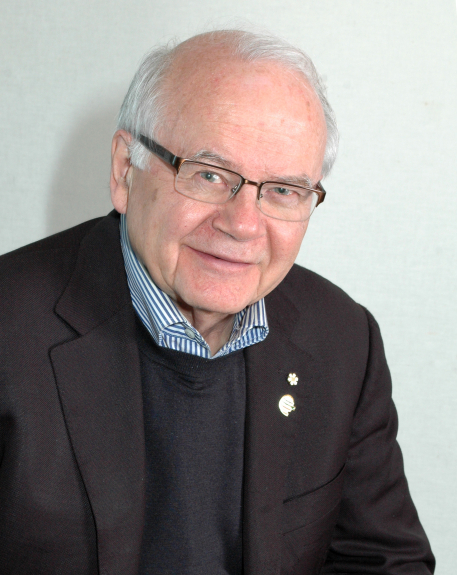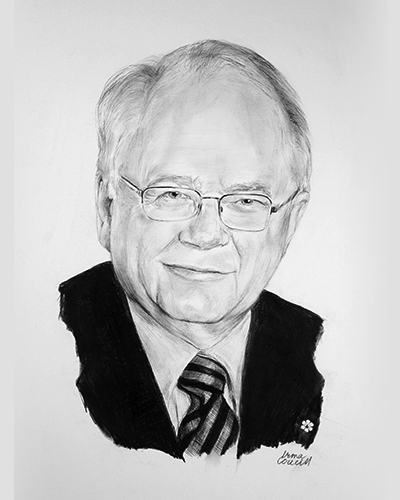2011 INDUCTEE D. Lorne Tyrrell, MD PhD Infectious Disease, Allergy & Immunity, Leadership in Organizational Development
February 10, 1943
(Edmonton, Alberta)
MD, University of Alberta (1968)
PhD, Queen’s University (1972)
2022: Baruch S. Blumberg Prize
2021: Henry G. Friesen International Prize in Health Research
See All AwardsAwards & Honours:
2022: Baruch S. Blumberg Prize
2021: Henry G. Friesen International Prize in Health Research
2015: Killam Prize
2004: FNG Starr Award, Canadian Medical Association
2004: Fellowship in the Royal Society of Canada
2002: Officer of the Order of Canada
2000: Alberta Order of Excellence
1998: J. Gordin Kaplan Award for Excellence in Research
1998: Prix Galien, Pharmaceutical Manufacturers of Canada

Discovered the first oral treatment for hepatitis B and opened pathways of research for the treatment of other viral infections

Internationally recognized expert of hepatitis B (HBV)
An exceptional teacher, compassionate physician and accomplished researcher, Dr. Tyrrell has positioned the University of Alberta and Canada as a world leader in terms of hepatitis research and treatment. Aware of the similarities between duck and human hepatitis B viruses, he proposed Pekin Duck liver cells as an inexpensive model system to test HBV inhibitors. Due to his groundbreaking research, Lamivudine or 3TC was discovered to dramatically decrease HBV replication by up to 99.9%. It would become the first antiviral therapy drug for the treatment and control of HBV.
Key Facts
As a result of his discovery of Lamivudine, liver transplantation programs for hepatitis B carriers were reinstated
Developed a rapid diagnostic method for Epstein Barr Virus infections
Authored 150 peer-reviewed publications and awarded 10 million dollars in competitive research grants
Established the Glaxo-Heritage Research Institute at the University of Alberta, one of the most successful partnerships between academia and the pharmaceutical industry
Named as one of Alberta’s 100 Physicians of the Century in 2005
Played an important role in the creation of CIHR by serving on the initial task force
Professional timeline
Impact on lives today
Hepatitis B was once the tenth most common cause of death in the world. Prior to 1980, the only way to protect a person against Hepatitis B was to vaccinate and no treatment existed for those who already carried HBV. The ground-breaking work of Dr. Tyrrell has saved many lives and provided insight into other viral diseases in the hopes that many more will be aided in the future. Dr. Tyrrell spent the majority of his career contributing to Canada’s scientific excellence and ensured that others would be able to follow. In 2010, he secured the largest donation ever received by the University of Alberta, enabling him to found the Li Ka Shing Institute of Virology.

2025
-

Lorne Tyrrell inducted into the Canadian Medical Hall of Fame
London, Ontario
-
Dr. Tyrrell’s hepatitis studies extended to hepatitis C, where, with two colleagues, he developed another model system, an immunodeficient mouse with a humanized liver
Infectious Disease, Allergy & ImmunityHundreds of compounds could now be tested as potential drugs against hepatitis C.
-
Lamivudine was licensed in Canada as Heptovir
Infectious Disease, Allergy & ImmunityThe drug was shown to forestall HBV’s life-shortening complications, transmission, and reinfection after liver transplantation.
-

Began his 10-year term as Dean of Medicine at the University of Alberta
Leadership in Organizational Development, Health and Medical Education & TrainingUnder his leadership, medical research space tripled, the Mazankowski Heart Institute was created, and Dentistry and Indigenous MD programs were reviewed.
-
Early Lamivudine drug trials began
Infectious Disease, Allergy & ImmunityLamivudine was discovered to decrease the viral count in the circulating blood by over 99%.
-
Dr. Lorne Tyrrell and his team discovered a new series of anti-viral compounds that had therapeutic potential for HBV treatment
Infectious Disease, Allergy & ImmunityLamivudine became the first oral anti-HBV drug for the treatment of HBV carriers.
-

Returned to the University of Alberta as an Associate Professor in Infectious Disease and Biochemistry
Leadership in Organizational Development, Health and Medical Education & TrainingHe later took on more leadership roles as the Director of Infectious Disease and the Chair of the Department of Medical Microbiology and Infectious Disease.
-
After completing his PhD, pursued post-doctoral training
He became a fellow of infectious disease at the University of Alberta and then travelled to Sweden to study at the Karolinska Institute in Stockholm.
1974
He has infectious enthusiasm.


